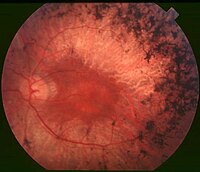
Hydroxamic Acid Inhibitors Provide Cross-Species Inhibition of Plasmodium M1 and M17 Aminopeptidases.
Sign Up to like & getrecommendations! Published in 2019 at "Journal of medicinal chemistry"
DOI: 10.1021/acs.jmedchem.8b01310
Abstract: There is an urgent clinical need for antimalarial compounds that target malaria caused by both Plasmodium falciparum and Plasmodium vivax. The M1 and M17 metalloexopeptidases play key roles in Plasmodium hemoglobin digestion and are validated… read more here.
Keywords: m17 aminopeptidases; hydroxamic acid; plasmodium; acid inhibitors ... See more keywords

Retinoic acid inhibitors mitigate vision loss in a mouse model of retinal degeneration
Sign Up to like & getrecommendations! Published in 2022 at "Science Advances"
DOI: 10.1126/sciadv.abm4643
Abstract: Rod and cone photoreceptors degenerate in retinitis pigmentosa (RP). While downstream neurons survive, they undergo physiological changes, including accelerated spontaneous firing in retinal ganglion cells (RGCs). Retinoic acid (RA) is the molecular trigger of RGC… read more here.
Keywords: vision; vision loss; degeneration; acid inhibitors ... See more keywords

N-Hydroxy-N-Propargylamide Derivatives of Ferulic Acid: Inhibitors of Cholinesterases and Monoamine Oxidases
Sign Up to like & getrecommendations! Published in 2022 at "Molecules"
DOI: 10.3390/molecules27217437
Abstract: Alzheimer’s disease (AD) is a complex disorder characterized by impaired neurotransmission in cholinergic and monoaminergic neurons, which, in combination with the accumulation of misfolded proteins and increased oxidative stress, leads to the typical features of… read more here.
Keywords: derivatives ferulic; hydroxy propargylamide; acid inhibitors; inhibitors cholinesterases ... See more keywords